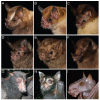Bats and zoonotic viruses: can we confidently link bats with emerging deadly viruses?
- PMID: 25742261
- PMCID: PMC4371215
- DOI: 10.1590/0074-02760150048
Bats and zoonotic viruses: can we confidently link bats with emerging deadly viruses?
Abstract
An increasingly asked question is 'can we confidently link bats with emerging viruses?'. No, or not yet, is the qualified answer based on the evidence available. Although more than 200 viruses - some of them deadly zoonotic viruses - have been isolated from or otherwise detected in bats, the supposed connections between bats, bat viruses and human diseases have been raised more on speculation than on evidence supporting their direct or indirect roles in the epidemiology of diseases (except for rabies). However, we are convinced that the evidence points in that direction and that at some point it will be proved that bats are competent hosts for at least a few zoonotic viruses. In this review, we cover aspects of bat biology, ecology and evolution that might be relevant in medical investigations and we provide a historical synthesis of some disease outbreaks causally linked to bats. We provide evolutionary-based hypotheses to tentatively explain the viral transmission route through mammalian intermediate hosts and to explain the geographic concentration of most outbreaks, but both are no more than speculations that still require formal assessment.
Figures



References
-
- Adams RA. Bats of the Rocky Mountain West, natural history, ecology and conservation. University Press of Colorado; Boulder: 2003. 302
-
- Agnelli P, Maltagliati G, Ducci L, Cannicci S. Artificial roosts for bats: education and research. The "be a bat's friend" project of the Natural History Museum of the University of Florence. HYSTRIX. 2011;22:215–223.
-
- Altringham J. Bats, biology and behavior. Oxford University Press; Oxford: 1996. 262
-
- Altringham J. Bats, from evolution to conservation. 2nd. Oxford University Press; Oxford: 2011. xv + 342
Publication types
MeSH terms
LinkOut - more resources
Full Text Sources
Other Literature Sources
Medical

